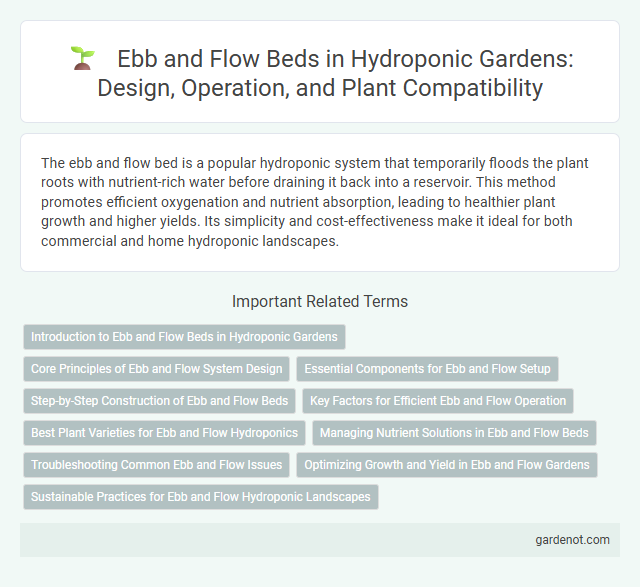The ebb and flow bed is a popular hydroponic system that temporarily floods the plant roots with nutrient-rich water before draining it back into a reservoir. This method promotes efficient oxygenation and nutrient absorption, leading to healthier plant growth and higher yields. Its simplicity and cost-effectiveness make it ideal for both commercial and home hydroponic landscapes.
Introduction to Ebb and Flow Beds in Hydroponic Gardens
Ebb and flow beds in hydroponic gardens use a flood-and-drain system to deliver nutrient-rich water to plants, promoting optimal root oxygenation and growth. This method involves periodically flooding the grow tray with nutrient solution, then draining it back into a reservoir, creating a cyclic watering schedule that enhances nutrient uptake and prevents overwatering. Ebb and flow systems are versatile and suitable for various crops, offering efficient water use and simplified maintenance for hydroponic landscapes.
Core Principles of Ebb and Flow System Design
The core principles of ebb and flow system design center on periodic flooding and draining of the grow bed, which ensures optimal oxygenation and nutrient absorption by plant roots. Precise timing and water volume control maintain a balance between moisture saturation and root aeration, promoting healthy plant growth while preventing root rot. Efficient pump cycling and appropriate bed media selection further enhance nutrient delivery and support robust hydroponic landscapes.
Essential Components for Ebb and Flow Setup
An effective ebb and flow bed requires several essential components, including a grow tray, a nutrient reservoir, a submersible pump, and an overflow drain to regulate water levels. The grow tray holds the plants and growing medium, while the pump controls the periodic flooding and draining cycles, ensuring roots receive ample oxygen and nutrients. Properly sized tubing and a timer are also critical for automating water delivery and maintaining optimal nutrient flow in the hydroponic system.
Step-by-Step Construction of Ebb and Flow Beds
Constructing ebb and flow beds begins with selecting a sturdy, watertight container to serve as the grow bed, ensuring proper size for the intended plant load. Install a submersible pump connected to a timer to periodically flood the bed with nutrient-rich water, followed by drainage back into the reservoir through a drain pipe equipped with an overflow valve for water level control. Layer the bed with an inert growing medium like expanded clay pellets, ensuring even distribution and stability for plant roots while maintaining efficient water flow and oxygenation.
Key Factors for Efficient Ebb and Flow Operation
Ebb and flow beds require precise control of flooding and draining cycles to maintain optimal oxygen and nutrient levels for plant roots. Proper timing, consistent water flow rates, and efficient drainage systems prevent root rot and ensure uniform nutrient distribution. Selecting appropriate growing media with good porosity and drainage enhances overall system performance and plant health.
Best Plant Varieties for Ebb and Flow Hydroponics
Leafy greens such as lettuce, spinach, and kale thrive in ebb and flow hydroponic beds due to their rapid growth and shallow root systems. Herbs like basil, mint, and cilantro also perform well, benefiting from the periodic flooding and draining cycles that provide essential oxygenation. Root vegetables such as radishes and carrots can be cultivated successfully with careful substrate management to maintain moisture without waterlogging.
Managing Nutrient Solutions in Ebb and Flow Beds
Managing nutrient solutions in Ebb and Flow beds requires precise control of solution timing and concentration to optimize plant growth. The flood cycle delivers nutrient-rich water directly to the root zone, while the drain phase aerates the roots, preventing oxygen deprivation. Regular monitoring of pH and electrical conductivity (EC) ensures nutrient availability and prevents toxic buildup in the hydroponic landscape system.
Troubleshooting Common Ebb and Flow Issues
Ebb and flow hydroponic systems often face issues such as pump failure, which can disrupt nutrient cycling and harm plant growth. Common problems include clogged tubing or drain pipes, which impede water flow and cause flooding or drying out of the grow bed. Regular maintenance and monitoring of water levels, pump operation, and system timers are essential to prevent and resolve these issues effectively.
Optimizing Growth and Yield in Ebb and Flow Gardens
Ebb and flow beds optimize plant growth and yield by cyclically flooding and draining nutrient-rich water to roots, enhancing oxygen availability and nutrient uptake. Precise control of flood intervals and water volume promotes root health, reduces disease risk, and supports vigorous plant development. Integrating automated timers and sensor monitoring can further optimize water delivery, ensuring consistent growth conditions for maximum crop output in ebb and flow gardens.
Sustainable Practices for Ebb and Flow Hydroponic Landscapes
Ebb and flow beds optimize water use by cyclically flooding and draining nutrient solutions, reducing waste and promoting efficient nutrient absorption for plants. Integrating renewable energy sources and automated timers enhances sustainability by minimizing energy consumption and maintaining consistent irrigation cycles. Utilizing organic nutrient solutions and recycling water within the system further supports eco-friendly practices in hydroponic landscaping.
Ebb and flow bed Infographic

 gardenot.com
gardenot.com